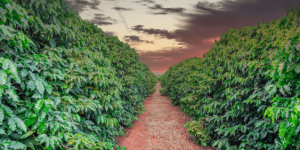Climate Contrasts in Channel Islands Agriculture: When Weather Creates Both Opportunity and Challenge
Jersey’s Sunshine Surplus
This past summer, Jersey experienced an unusual spike in sunshine, totaling 47.3 hours above the 30-year average.
This surplus of sunlight positively impacted plant health by providing extra energy for photosynthesis.
However, timing is crucial for crop development, and in some cases, like with grapes at La Mare Wine Estate, the additional sunshine came at less than ideal times.
Too much sun at the wrong moments can disrupt the delicate balance needed for optimal grape ripening, showcasing the double-edged nature of this weather anomaly.

Guernsey’s Rainfall Abundance
Conversely, Guernsey faced a significantly wetter season with 26.4mm more rain than usual.
This rainfall surge proved beneficial for crops like maize, where ample soil moisture is essential for root establishment and growth.
Farmers on Guernsey, such as Julian Ogier from Le Hechet Farm, observed notable advantages, such as robust maize crops.
Yet, the increased rainfall also presented challenges, particularly during harvest.
Wet field conditions complicated the use of heavy machinery, risking soil compaction and logistical hurdles.
Impact of Geographical Positions
The differing weather patterns between Jersey and Guernsey can be attributed to their unique geographical positions and surrounding wind patterns.
Jersey’s southern location allows for more direct sunlight and drier conditions, while Guernsey’s proximity to the Atlantic exposes it to more rainfall.
These geographical traits underscore the critical role location plays in shaping weather outcomes and, consequently, agricultural productivity.
The ability of Channel Islands farmers to adapt to these weather conditions illustrates the complex interplay between geography and agriculture.
This resilience ensures that they can maximize their productivity while safeguarding their farms’ long-term sustainability.
Guernsey’s Agricultural Success Story
Rainfall’s Role in Maize Growth
This summer, Guernsey experienced a remarkable boost in its maize crops thanks to 26.4mm more rainfall than usual.
The increased moisture in the soil created optimal conditions for the maize to establish sturdy roots and thrive.
Julian Ogier, a farmer from Le Hechet Farm, noted that the ample rain provided a significant advantage, resulting in robust growth and a “bumper crop.”
Harvesting Hurdles
However, the abundant rainfall wasn’t without its downsides. Wet field conditions posed significant challenges during the harvesting period.
Heavy machinery such as harvesters and trailers, essential for collecting the crop, risked causing substantial damage to the wet soils.
Ogier highlighted the logistical nightmare of harvesting in such conditions, pointing out the potential soil compaction and the sheer amount of mud that would be carried onto roads.
Balancing Benefits and Long-Term Health
Balancing the immediate gains from the maize crop with the long-term health of the soil is a continuous challenge for farmers.
While the increased rainfall promised short-term benefits, the risk of soil degradation and compaction from heavy machinery remains a concern.
This scenario underlines the importance of sustainable practices to ensure soil health for future agricultural cycles.
Adapting to these varying conditions proves essential in maintaining agricultural success in the Channel Islands.
Understanding the necessity for flexibility and resilience, farmers are learning to navigate the shifting weather patterns to sustain their productivity and long-term sustainability.
Jersey’s Vineyard Challenges
Critical Timing Requirements for Grape Development and Ripening
Grape cultivation in Jersey demands precise timing throughout the growing cycle, particularly in the final stages of ripening.
Vineyards like La Mare Wine Estate rely on careful coordination of environmental factors during these crucial last weeks.
The development of grapes involves a critical period where the correct amount of sunshine, ventilation, and consistent moderate temperatures directly impact the sugar content, color, and overall quality of the grapes.
Any deviation from this perfect weather synergy can significantly influence the ultimate harvest.
Impact of Mistimed Sunshine on Grape Quality
This year, Jersey faced a mismatch in the timing of its otherwise abundant sunshine.
Specifically, the vital final 4-6 weeks of grape ripening saw inconsistent sunny intervals, which proved detrimental.
Optimal ripening requires a steady supply of sunshine to facilitate sugar accumulation in the grapes and prevent the onset of mold due to damp conditions.
Unfortunately, the untimely sunshine disrupted this delicate balance, leading to a compromised grape quality.
The La Mare Wine Estate, for example, noted that while the vineyard received adequate sunshine overall, the critical ripening period suffered from irregularity, culminating in subpar grape development.
Importance of Specific Weather Conditions During Final 4-6 Weeks
Achieving the right weather conditions during the last few weeks of the grape growing season is paramount for Jersey’s vineyards.
In these concluding weeks, grapes need a fine-tuned mix of warm temperatures, controlled humidity, and well-ventilated air to fully mature and develop their desired flavor profiles.
The sporadic pattern of sunshine and other climatic inconsistencies this season highlighted the fragility of viticulture in Jersey.
Growers emphasize the need for patience, as unfavorable weather patterns are beyond their control and can profoundly impact the quality of their harvest.
This scenario underlines the broader agricultural challenges faced in Jersey, as the grape ripening process is highly sensitive to specific environmental conditions.
Farmers in Jersey must remain adaptable, continuously monitoring weather forecasts and adjusting their practices to mitigate potential adverse impacts on the crops.
This ability to adapt quickly is crucial across all agricultural sectors on the Channel Islands.
Next, we will explore how these weather intricacies impact greenhouse farming, where internal conditions must be managed despite external weather influences.
Greenhouse Farming Adaptations
Managing Indoor Growing Conditions
Despite the controlled environments of greenhouses, external weather influences remain a significant challenge for farmers in the Channel Islands.
This summer, increased rainfall and limited sunshine demonstrated how even greenhouse crops can be affected by external factors.
According to Jock Pettitt of The Soil Farm in Guernsey, “We are not immune to the weather,” which significantly reduced light levels inside the greenhouses, impacting plant growth.
Balancing Humidity, Ventilation, and Wind Protection
Effective greenhouse farming involves a delicate balance to maintain optimal growing conditions.
Key factors that need constant adjustment include:
- ✅Humidity Regulation: High humidity levels require opening vents to allow the space to breathe and prevent mold growth.
- ✅Ventilation: Adequate airflow is essential for plant health, particularly in preventing disease and ensuring plants receive sufficient carbon dioxide.
- ✅Wind Protection: During high winds, closing vents is necessary to protect both the structure and the crops inside.
Constant Monitoring and Adjustment Requirements
Greenhouse farming demands vigilance.
Farmers must frequently adjust their practices based on changing weather conditions, continually monitoring factors like humidity, air temperature, and light exposure.
During periods of reduced natural light, supplementing with artificial lighting is crucial for ensuring ongoing plant growth.
By continuously adapting their approach, Channel Islands’ greenhouse farmers can mitigate some of the adverse effects of erratic weather patterns.
This adaptability is vital for maintaining crop health and productivity, particularly amidst the unique climatic challenges of the islands.
Next, we delve into the intricacies of livestock management, exploring how varied weather patterns impact grazing and feeding strategies.
Livestock Management in Varying Weather
Impact of Rainfall on Grazing Patterns and Animal Behavior
Rainfall significantly influences livestock behavior and grazing patterns in the Channel Islands.
The increase in rainfall experienced by Guernsey, as opposed to Jersey, has both its advantages and challenges.
For instance, lush green pastures from ample rainfall might seem beneficial for grazing animals.
However, livestock such as the Golden Guernsey goats often seek shelter during even light rain, reducing their grazing time.
This behavior affects their diet and overall health, necessitating farmers to adapt their livestock management strategies constantly.
Need for Supplementary Feeding Strategies
When persistent rainfall reduces natural grazing periods, farmers must deploy supplementary feeding strategies to ensure their animals receive consistent nutrition.
These strategies often involve extra operational costs and meticulous planning.
The goal is to maintain livestock health and productivity despite reduced access to fresh pasture.
Thus, having a robust plan for supplementary feeding becomes crucial, ensuring that livestock nutrition remains consistent regardless of weather conditions.
Positive Effects on Winter Feed Stock Quality
Despite the challenges posed by increased rainfall, Guernsey’s farmers have noticed a silver lining when it comes to winter feed stock.
The abundant rainfall has led to exceptional hay quality, which is crucial for maintaining milk production throughout the winter months.
High-quality hay provides essential nutrients, contributing significantly to stable milk yields even when natural grazing is not possible.
Farmers like Peter Girard of the Golden Guernsey Goat Farm have found that improved winter feed quality helps keep milk production relatively steady, showcasing the resilience and adaptability needed in livestock farming.
As we continue to explore the multifaceted impacts of Channel Islands’ weather on agriculture, we turn our attention to the broader implications for flexible farming approaches and long-term sustainability.
This ongoing adaptability highlights the importance of resilience in navigating the challenges and opportunities presented by the Islands’ unique climate.
Future of Channel Islands Agriculture
Importance of Flexible Farming Approaches
In the ever-changing environmental conditions of the Channel Islands, the need for flexible farming approaches stands out as a key takeaway for modern agriculture.
Guernsey’s remarkable maize yield due to 26.4mm of additional rainfall exemplifies the benefits of adaptability.
Yet, the wet conditions highlighted the importance of being able to adjust harvesting techniques and timing to prevent soil degradation and machinery difficulties.
The diverse weather conditions, stemming from their unique geographical locations and wind patterns, mean that farmers must be prepared for anything.
Whether it’s adapting to increased rainfall in Guernsey or managing the surplus of sunshine in Jersey, the ability to pivot and reassess farming strategies is vital.
This flexibility helps mitigate the challenges posed by unpredictable weather patterns, ensuring that productivity remains consistent.
Balancing Immediate Productivity with Long-Term Sustainability
Farmers on the Channel Islands are constantly balancing immediate productivity with the long-term health of their land.
Immediate gains, such as bumper crops, are undoubtedly significant. However, practices must be sustainable to maintain soil health and overall environmental resilience.
Harvesting in wet conditions, for instance, can compact soil and reduce its future productivity if not carefully managed.
Greenhouse farming also demands a constant balancing act.
While controlling humidity and ventilation can optimize immediate crop success, these factors must be aligned with external weather conditions for long-term crop health.
Farmers continually manage these variables, showcasing their commitment to sustainable agricultural practices.
Lessons Learned from Contrasting Weather Patterns
The contrasting weather patterns between Jersey and Guernsey provide valuable lessons in agricultural adaptability.
Jersey’s vineyards need precise timing of sunshine and weather conditions, emphasizing that success often lies in synchronizing weather elements rather than simply having an abundance.
Guernsey’s increased rainfall benefits crops like maize but poses logistical challenges during harvest, teaching the importance of being ready to adapt machinery and harvest timing as needed.
These lessons underscore the significance of understanding and working with specific environmental conditions.
By internalizing these learnings, farmers can better prepare for future weather variability, enhancing both productivity and sustainability.
As we look to the future of agriculture on the Channel Islands, the ability to adapt and maintain sustainable practices remains essential.
Farmers’ resilience in the face of unpredictable weather patterns exemplifies the strength and ingenuity needed to thrive, ensuring that agricultural productivity continues to flourish amidst varying environmental conditions.






